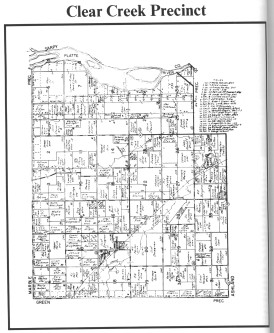CLEAR CREEK
On Feb. 1, 1871, it was ordered that Clear Creek precinct be established and defined. Part of it came from what had been Ashland. It is bound on the east by the Platte River. The Precinct took its name from the stream called Clear Creek which runs from N. to S. across the land on its way to the river near Ashland.
Reuben L. Warbritton came to the state in August, 1856, and located in Cass Co. In the spring of 1857, he moved to Saunders Co. and settled on Sec. 27, Clear Creek about March 1, 1857; he was the first white settler to move his family to Saunders Co about April 1, 1857. He was born in Indiana on Oct. 6, 1828. He was the second Co. Clerk in Saunders Co. He was married at Frankfort, Ind., Dec. 5, 1833, to Hanna J. Aughe, who was born in Ohio, 1832. Three children were born to them; Sarah J., William J., and James L.
Hobart Brush came to Nebraska in 1863 and came to Saunders Co. in 1867, took up a homestead in Sec. 2 in Clear Creek P. where he remained until 1873; when he went to Ashland and opened a drug store. He was the first Co. Clerk of Saunders Co. Frank W. McIntyre came to Clear Creek in 1868.
Jacob Saunders came to Nebraska in the autumn of 1863 and located on a farm in sec. 26, Clear Creek. His brother, William, came with him and located a short distance north of his land. They were among the first settlers in the vicinity. They were Pennsylvanians. James R. Hayward settled in 1866.
Precinct Officers: Chairman -- Steven V. Frahm, Clerk -- Robert L. Nelson, Treas. -- Kevin L. Ziegenbein.
ILIFF CHAPEL UNITED
METHODIST CHURCH
The church building was moved to its present site just outside Memphis in 1908, on ground purchased from Thomas E. Owen. During construction of the west room, entry and the bell tower, services were held in the United Brethern Church, located across the street, north of the Memphis School House.
Dr. Thomas C. Iliff returned to Memphis on Sept. 6, 1908, to rededicate the expanded building of his namesake church in the morning services.
Total cost of moving and expansion project was $3800. By 1915 the United Brethern denomination closed its Memphis Church and the building was sold. The members were merged with the Iliff Chapel Methodists more than 50 years before the Methodists and United Brethern merged nation-wise.
Until 1935, Memphis and Ithaca shared ministers. Ithaca had the morning service and Memphis evening.
On June 25, 1933, the "50th" anniversary of the Iliff Chapel was celebrated. It was really the 53rd. This was an all-day affair.
Student ministers served the Memphis Church in 1936-38. They lived in a parsonage donated by Thomas J. Colbert, who had stipulated it was never to be sold, and when the congregation no longer wanted it, it was to revert to Mr. Colbert's heirs.
In 1939 Memphis was yoked with Cedar Hill charge with Rev. Walter Neth as pastor. He had served before with Ithaca and Memphis. In 1943 he introduced the "God's Acre" program to help supplement the budget. This year the Ladies Aid selected the first prince and princess to represent Memphis at Ashland Stir-up; Billy Grauerholz and LaVon Wicht, the representatives. In 1968, Memphis was transferred to the Omaha District to be in with Ashland.
The 60th anniversary of the rededication of the Iliff Chapel on Sept. 6, 1908 was observed on Nov. 17, 1968.
Dr. Jackman, the minister, also celebrated his 50 years with the ministry.
The members raised more than $800 for new sanctuary carpet, entrance-way carpeting and paneling.
This was also the year the Methodist Church merged with the Evangelical United Brethern, so the local church's name was changed to Iliff Chapel United Methodist Church.
In 1977, Iliff Chapel became a modern building as the Village of Memphis installed water and sewer systems. The congregation still uses the "God's Acre" program to help subsidize the budget.
For the centennial in 1980, the people again rallied and had the ceiling redone with beams, repapered the sanctuary, and the pews were refinished. They are keeping the custom established by the forefathers "pay as you go," thus keeping the building free from debt. A new illuminated wooden cross was installed. One hundred and eighty-six guests signed the guest book on Sunday, Sept. 14th, for the all day event. A truly great day for rejoicing the centennial.
MEMPHIS
The Village of Memphis, Clear Creek Precinct, is located between Ashland and Wahoo on the Schuyler branch of the Burlington Railroad.
The town had its beginning when the first train chugged into the station, Febr. 1887. The plots were ready for sale to the public July 15, 1887. The land had belonged to John C. Owen, who homesteaded the area.
As the town began to take shape, stores and elevators were built to further accommodate farmers.
The Duff Grain Elevator was the first in 1890. This later became the Farmers Union. At one time two elevators served the community.
In the early 1890's Snell and company built a general merchandise store. The first Post Office was located in this store.
This first store was destroyed by fire and rebuilt. Over the years various types of business were conducted; it is now vacant.
In 1897 the first two story structure for stores were built, with the upper level being used for the social life in the area. General elections were also held there during election times. The lower housed two stores. This burned in 1915.
 |
| Dale Roger's farm in 1978 flood near Memphis |
Grauerholz Brothers built a new store in 1915. It was also a two story structure. The upper level, Town Hall, was for the social life and general meetings. The Izaak Walton League had its organizational meeting here. The lower stores; the north was general merchandise and the southern room held various business enterprises. This building burned one cold February night in 1951.
In 1956, Don Washburn built a store on the location and it is now owned by Mr. and Mrs. Don Cronican.
Another popular place was a brick store, located south of the above. It started out as a general merchandise, then later became a Corner Drug operated by Dr. Packer and George Baker. Dr. Packer was the local physician. Mr. Baker came to Memphis May 10, 1917. He was a native of New York. They opened the Drug Store January 1, 1918. Mr. Baker became a fine leader of the community. He died in the early 1940's. He remains in the memory of many as one who did much to make Memphis a better community.
Gary DeFoil opened a grocery-tavern store in this building in 1951. The interior burned a few months after its opening.
Anderson and Frank had a combination store and lumber yard. Frank sold his interest to Wm. Molzen in 1911. Then Anderson and Molzen built an addition to include hardware in 1921.
This was a highly successful business, then the Ehlers Mercantile on the block served the community for many years.
The bank was organized in 1902, capitol stock of $5,000 and usually carried a surplus of from $6,000-$10,000. For over 20 years of business the bank averaged a general deposit of from fifty to seventy-five thousand dollars. H. H. Ehlers was cashier for many years. Nellie Mayfield Colbert started as a clerk in 1921 and continued and was cashier, when it closed in 1932. The Depositors didn't lose any money. The Farmers and Merchants Bank in Ashland took over the assets and liabilities. The depression was the cause of the bank closing. Many a school kid went to Nellie for help, especially math.
The Post Office was established May 15, 1889. It was moved from store to store until its present location.
The Armour and Company Ice House built in 1897 helped the economy of the community. The building burned in 1921. The ice harvest continued to the mid thirties, when manufactured ice became popular.
Our first Doctor was Dr. Mary Quincy in 1896. She also served as the first secretary of Saunders County Medical Association, which was organized in 1903.
Dr. Baer was the last doctor to live in Memphis and with his wife, the former Mary Ziegenbein, moved to Ashland in 1924.
The school was formed in 1891 as District 110, a one-room structure. Beginning salary for the teacher was $25.00 per month. Mr. Ed Cullen was the first teacher. Another room was added on to the south in 1903 when the ninth grade was added.
In 1910, -- 110 children attended school and by 1919 the enrollment was so large, the overflow had class in the old Snell store. The tenth grade had been added before and by 1919, five teachers were in charge.
The high school was voted out in 1950 and the school reverted to a "one" room school. In 1961, District 32 contracted to send their children to Memphis. Two teachers were then needed. Kindergarten through 4th grade occupied the south room and 5th through 8th, the north room. In 1964, District 41 dissolved and became a part of the district. Today the school has 31 pupils, with Mrs. Elaine Jung and Mrs. Pat Yardley, teachers and Mrs. Luetkenhaus as aide.
The United Brethren Church was built in 1898, located across from the school house. All who joined were baptized by immersion in Owen's lake just south of town on the east side of the bridge. This church building was later sold and moved to a farm.
The Iliff Chapel was moved in 1907 from the country. The little church has 59 members with Dr. Samuel Rathod as pastor.
Dr. Thomas was the first in the community to own a car, a Holman. Frank Gumery, owned the second, a Gail, with Fred and Henry the third, a Reo. Today, we have the Malmo Elevator, with Jim Kucera, manager at Memphis. Don's Bar owned and operated by Mr. and Mrs. Don Cronican. The Post Office, Mrs. Carl Ziegenbein, postmistress. Mr. and Mrs. Clarence Sander's Corner Store. The Ye Olde Snack Shoppe at the Memphis State Lake. The Memphis Lake, a very popular spot in the summer, maintained by the Nebraska State Game and Parks Commission.
34 families reside in the village, enjoying the quiet atmosphere of the small community.
DEER ON THE "PLATTE
BOTTOM"
Addison Carr, one of the earliest residents (1866) of Clear Creek precinct handed down this story (parts of which follow):
"This country was known as a part of the Great American Desert. After having crossed the plains 28 times from 1858, hauling freight into the Rocky Mountains, I located on the bluff overlook-
page 69
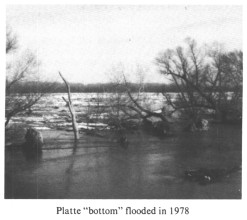 |
| Platte "bottom" flooded in 1978 |
ing the great Platte Valley. My first house, consisted of one room, dug back into the bluff, in which we had a fireplace with a sod chimney, one door and one small window, and mother earth for the floor. The winter of '66 and '67 was quite severe, not withstanding the fact that we were very comfortable in our winter quarters as far as warmth was concerned. Dreary indeed, were many of the cold winter nights, with the snow drifted over our apartments and the wolves howling apparently upon our very house top. In the spring of the year, we counted as high as 50 deer at one time on the Platte bottom in sight of our crude home.
We lived on the Pawnee Indian Trail and suffered no little inconvenience from them, as they went to and fro to visit the Otoe tribes."
MEMPHIS POST OFFICE
About 20 miles southeast of Wahoo in the Village of Memphis live close to 120 people.
Big Black letters across the front of the small building announce: U.S. Post Office, Memphis, Nebraska, 68042.
If you were to mount the steps and open up the wooden screened door you'd find tidy rows of 68 metal mail boxes next to the big open window surrounding the pleasant face of Myrtle Ziegenbein, the post master. Mrs. Ziegenbein became the officer in charge in 1972, and in 1974, she was appointed as the official postmaster. Nick Robinson is the leave replacement on Saturdays.
If you want to find anything out about the history you should go talk to Hazel Owen. She's the retired postmaster -- has 38 years of experience, and also owns the building. Hazel and her husband, Leonard Owen, qualify for resident historians because they are among the few original Memphis residents left -- along with Bill Grauerholz, Jr. and his mother Sylvia, Cecil W. Molzen and Bessie Grauerholz Wright.
But getting back to the post office building, Mrs. Owen's great-grandpa owned all the farmland around Memphis. When the Union Pacific railroad wanted to run through his land, he gave them a grant, but he contracted to reserve the town site for himself. As he sold lots, he decided to keep every other one for himself because he had quite a few children. Eventually many of them built in town. When Mr. Owen retired and moved off his farm one-half mile north of town, he moved into what is now the postoffice. Hazel Owen's brother-in-law, Roy F. Owen, a retired federal game warden, is 92 years old and he was born there.
The little post office has been resided, plastered, and roofed although there is still no water in the building.
The Village of Memphis with its diminutive post office established May 15, 1888, John W. Barr serving as original postmaster, is still a tiny third-class post office, but many folks will continue to visit the post office for many years to come.
THE CLEAR CREEK DRAINAGE
DISTRICT
The Clear Creek drainage district was organized in 1907. Dennis Grimes was one of the promoters of the ditches and the river dike, and the first secretary. He was associated in the work with George Heldt, treasurer, and Martin Shupe, assistant secretary. B.E. Hendricks was the first lawyer the board hired. The board consists of seven members: George Heldt, Dennis Grimes, Martin Shupe, Al Laverty, Sam Sanders and Tim Carey.
The by-laws were made up in 1908, signed by Tim Carey, and Dennis Grimes. The Wahoo Democrat newspaper did all their printing (Now the Ludi Printing Company). The banks that did their business down through the years were: Bank of Wann, Bank of Yutan, Farmers and Merchants of Ashland and Citizens National of Ashland. Martin Shupe was sworn in August 21, 1907, to show that the assessments on all the land to be true as it was written in the petition.
June 4, 1923, Joe Laughin was voted to over-see the work done on the river at $5.00 an hour. No records were available in the minutes of the meetings as to when the dike was actually begun.
A new ditch, Ditch #6 was organized in 1924. Estimated cost of $33,265. (the big ditch at the foot of the bluff). Down through the years most of the labor was done by local men. May first, 1929, two men and two teams made $8 an hour. They used hay to make blankets for rip-rapping. A load of hay cost $2.00. In January 1928, 15 loads of hay cost $5.00.
In May, 1930, the county was called to help get the dredge out of the mud at $8.50 an hour. Roy Petersen ran the dredge.
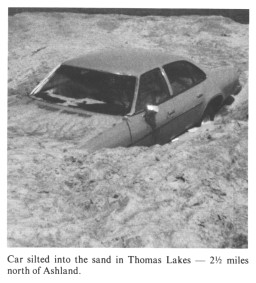 |
| Car silted into the sand in Thomas Lakes -- 2½ miles north of Ashland. |
In 1935, the river had cut away some land and work had to be done on the river. Land had to be bought from Maggie Sievers. She sold them land for $150.00 an acre. (north end of the river dike). Wages then were 50¢ an hour for one man and a team. Martin Ballou was hired to pump sand on the river, August 1936, at $2.50 an hour. Also in the spring, Yutan men were hired to do dynamiting.
In September, Harvey Lehr and Clayton Dodfrey were hired to work on the river. Mr. Lehr did a lot of work on the river down through the years. Materials for the boat that the sand pump was on, was bought from Mead Lumber in Ashland in October 1938.
The minutes were not available for a few years but in 1960 a big flood was caused by ice jams. (east of Geo. Ohms). It washed out much of the dike south of Tarpennings old place. (where Bill Haldeman lives now). The dike had to be moved back 200 feet. Many farmers lost cattle in the ice water.
March 22, 1978, an icejam caused the river to cut a new channel parallel to the dike. Farther down the river another gorge formed above Melvin Thomas's home. It washed the house and cars in the lake, moved foundations, and washed a lot of dike away; silted in sand and filled drainage ditches.
The board applied for relief from Federal Disaster Assistance. It was granted.
March 1980, the river had cut into the dike and work had to be done immediately. Slabs of cement were acquired from the old ordinance plant at Mead. Men were hired to break it up and haul it to the river. Eleven jetties were made. Help for this was obtained from the N.R.D. (Natural Resources District).
Almost all land owners in the district from 1908 have been on the board at some time.
The present board members are: George Ohm, Bill Haldeman, Don Veskerna, Delmer Kolb, Ed Yocum, C. J. Anderson and Charles Karloff. Submitted by Mrs. Elmer Miller
ICE HOUSE TO STATE PARK
In 1897 Armour and Co. built an Ice House on the north edge of Memphis on a 40 acre site purchased from H. C. Henry, who was forced to sell some of his land due to the severe farm depression of the 1890's.
The lake was man made contractors dredged it out and put up dikes. Several springs were discovered on the north end of the lake. Some of the water was diverted from Silver Creek located about ½ mile north. Every fall the lake was filled with water and each spring it was drained off. The ground was used for pasture or farm crops. In the fall the ground was cleared of debris and since horses were used, even the droppings were cleared away.
This ice was the purest in the state and was known as lemonade ice.
The ice house measured 200 feet wide, 735 feet long and 40 feet high. Originally there were 12 rooms to store ice and later 8 more rooms were added. Each room measured 150 feet by 32 feet. The north room housed a 300 horsepower steam engine
and two dynamos which were fired with coal. This made their own electricity. Frank C. Owen hauled the first load of lumber for the ice house.
The Ice House provided work for 25 local families and during the busy season as many as 300 men were shipped by railroad cars by Armour and Co. from Omaha and surrounding towns to carry the work load. The salary was 15¢ per hour, later raised to 19¢ or $1.90 for a 10 hour day.
There were some itinerant workers among the workers and many of these were so impoverished that they had their feet wrapped with gunny sacks as they had no shoes.
They were housed at the Armour Boarding House located south of the plant. This boarding house could house 300 men. Each room contained bunks and housed 12 men. It was 3 stories high and besides the bedrooms, there was a sitting room (smoker's lounge), a kitchen, and a dining room. Cooks, waiters and dishwashers were brought in from out of town for the busy period. Board and room here was 50¢ a day.
The method employed in putting up the ice could be described as follows: --
When the lake was frozen over, a channel would be cut and maintained open to where the ice elevators entered the lake. When the ice became 8 inches thick, the harvest would begin. The ice would first be plowed into 40"x20" cakes, using a scorer drawn by a team of horses. Whenever the horses fell through the ice, they were choked down so that they would float to the top and then could be removed from the water.
Sawing the ice would then follow. These blocks would then be pike-poled. (this was a wooden pole, about 1½" in diameter and 10 to 12 feet long with a sharp metal spear type end to push the ice in the channel to the elevator and into the ice rooms). The attic was filled with saw dust. When the ice was removed the last ice in the building was the first to go out. The railroad tracks ran right up in front of the ice house. As many as 24 railroad cars of ice a day were hauled out. The first foreman of the plant was Mr. Cripe followed by Charles Tanner, who remained here after the ice house burned in 1921.
In the early morning hour when the ice house caught on fire -- a lot of pigeons roosted in the attic. Hundreds of pigeons perished in the fire. The bearings on the steam engine were encased in babbit and this babbit became so hot during the fire that it
page 70
melted and dripped down forming the shape of a pigeon, almost a tribute to the many birds that perished.
Harvesting of ice continued, but the ice was put directly into railroad cars and as before local families and store owners had their own storage facilities (small underground ice caves. This ice usually covered with straw and used during the summer for cool drinks and in individual ice boxes).
Later manufactured ice and refrigerators came into being. The Izaak Walton League, under the leadership of Roy Owen, George Baker, Emor Ballou, and others worked for a State Park to be made from this area. In 1930 this became a reality. Local 4-H groups planted trees and watering of the trees during the drought era was done by townspeople. The lake was stocked periodically with game fish.
Improvements have been made under the Game and Parks Commission that today, make this park a popular place for many. It is known as the Memphis State Park. by Bessie Wright
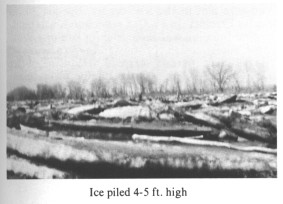 |
| Ice piled 4-5 ft. high |
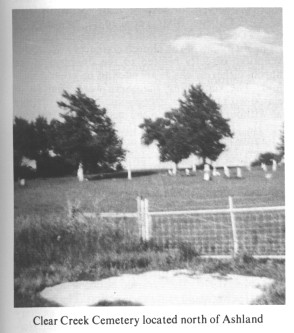 |
| Clear Creek Cemetery located near Ashland |
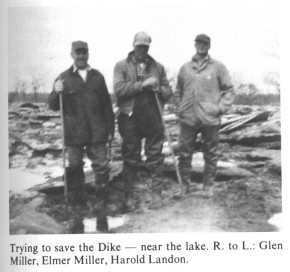 |
| Trying to save the Dike -- near the lake. R. to L.: Glen Miller, Elmer Miller, Harold Landon. |
 |
DOUGLAS PRECINCT |
 |
| (image links to larger map) |
DOUGLAS PRECINCT
December 3, 1866: Saunders County was divided into the three precincts of Pohocco, Douglas, and Union. Douglas Precinct included all lands west of the range line between ranges 6 and 7 and north of the north line of town 15.
April 6, 1868: Town 15 in ranges 5 and 6 were set off and attached to Douglas Precinct
August 24, 1869: The county was divided into the voting precincts of Chapman, Marietta, Wahoo, Oak Creek, and Douglas. Douglas included towns 16 and 17 and ranges 5 and 6.
Douglas Precinct is bounded on the north by Morse Bluff, Cedar on the east, Mariposa on the South and Chester on the west. Three small creeeks run through the precinct. Sand Creek is located in the northern part of the precinct, with Spring Creek starting in the central part of the precinct, and Duck Creek found in the lower part.
No information can be found as to how the precinct received its name. It may have been named after Senator Douglas or after the neighboring county of Douglas in Nebraska. As of 1982, the precinct is still strictly a farming community with no sign of a store or church left.
Township officers 1983-87: Chairman -- Milton Odvody; Clerk -- William A. Vech; Treas. -- Robert A. Dauel.
The first sermon was preached by James Kuypers in his dugout in 1869-70. Mr. Purson of the Methodist Episcopal Church organized the first religion class. Later Rev. Gregory ministered to the early settlers in the community. Later Mr. James Kuypers organized a Sunday School which met at the schoolhouse. In 1875, Rev. J. Amlong organized a Presbyterian Church.
The first school in the precinct was formed in 1870. John Wikell taught at the school with the following officials: Moderator -- Ahram Lees, Director -- John Wilcox, Treasurer -- Mr. Simpson.
The first birth was a son to J. TePoel and wife in 1870.
In 1870, the Sand Creek Post Office opened in Douglas Precinct with R. Fleming as first postmaster.
A special gift arrived to the Jones family in 1882. Charles A. Jones was born on Christmas Day. His parents were from the state of Indiana.
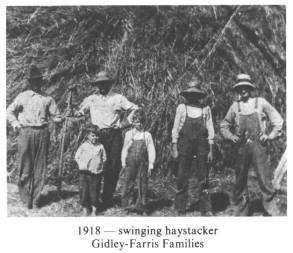 |
1918 -- swinging haystacker
Gidley-Farris Families |
Thomas W. Farris was born in Douglas Precinct in 1876. He was the youngest man ever elected to the office of sheriff in the state of Nebraska in 1899. He finished the term of his father who had been sheriff.
February 1876, was the year for two prairie fires in Saunders County. On February 12, a fire was found in the southwest part of Saunders County and provided large losses. Douglas Precinct was hit with
page 71
| 
